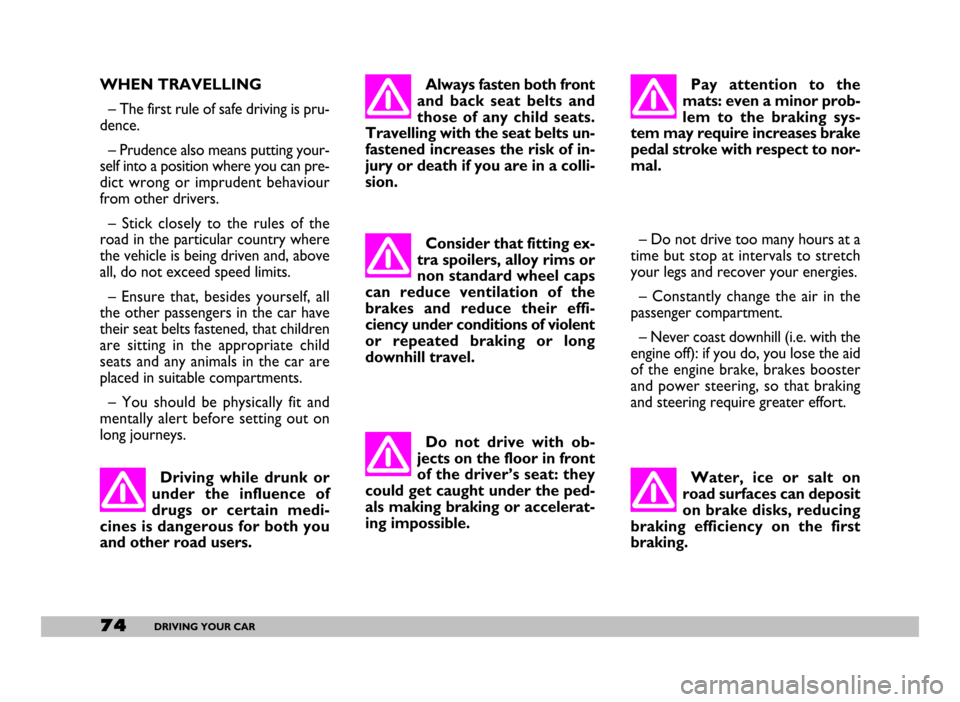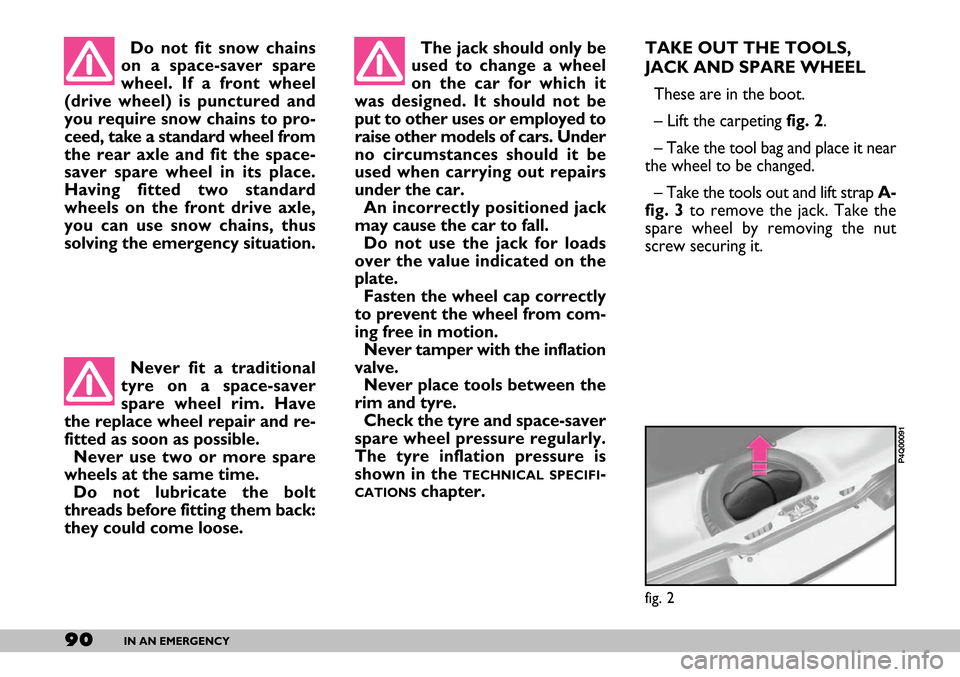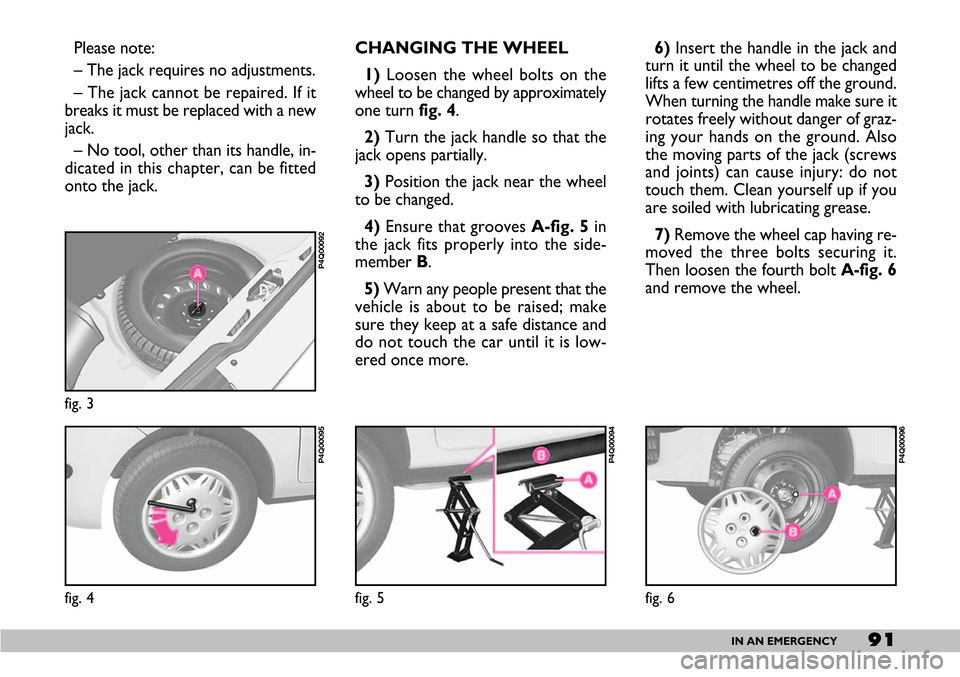2007 FIAT SEICENTO change wheel
[x] Cancel search: change wheelPage 39 of 154

38GETTING TO KNOW YOUR CAR
Flashing the headlights fig. 39
Pull the stalk towards the steering
wheel (temporary position) to flash
the lights.Direction indicators fig. 40
Move the stalk as follows:
upwards - to turn the right-hand in-
dicators on;
downwards - to turn the left-hand
indicators on.
Instrument panel warning light y
will flash.
The direction indicators will auto-
matically be switched of when the car
is straightened out.
If you want the indicator to flash
briefly to show that you are about to
change lane, move the stalk up or
down without clicking into position.
When you let it go it will return to its
original position. RIGHT-HAND STALK
Windscreen wiper/washer
fig. 41
The device will only work when the
ignition key is at MAR.
Controls:
0- Windscreen wiper off
1- Flick wipe
2- Continuous wipe
3- Continuous fast wipe
4- Temporary position: when re-
leased the stalk returns to 0and au-
tomatically switches off the wind-
screen wiper.
fig. 39
P4Q00052
fig. 40
P4Q00014
fig. 41
P4Q01045
Page 74 of 154

73DRIVING YOUR CAR
IMPORTANT Reverse gear can
only be engaged when the car is com-
pletely stationary. With the engine
running, before engaging the reverse
gear, wait for at least two seconds
with the clutch pedal pressed fully
down to avoid damaging or grating the
gears. SAFE DRIVING
In designing the Fiat 600, Fiat has
made every effort to come up with a
car able to provide driver and pas-
sengers with top-class levels of safety.
Nevertheless it is always the behav-
iour of the person at the wheel that
determines road safety.
Below you will find some simple tips
to help you travel in safety under dif-
ferent conditions. You will no doubt
be familiar with many of them already
but it will be useful to read them all
carefully.
BEFORE GETTING BEHIND
THE WHEEL
– Make sure all lights including the
headlights are working properly.
– Adjust the position of the seats,
steering wheel, inside and outside rear
view mirrors properly for the best
driving position.
– Carefully adjust the head restraints
so the back of the head and not the
nape of the neck is supported. – Make sure that nothing (mats etc.)
gets in the way of the pedals when
they are pushed down.
– Make sure that any child restraint
systems (child seats, carriers etc.) are
properly fixed preferably on the back
seat.
– Place any objects in the boot in
such a way that they cannot be
thrown forwards in the event of an
accident.
– Do not eat a heavy meal before
travelling. Light eating will help keep
your reflexes prompt. Above all, do
not have anything alcoholic to drink.
Periodically, remember to check:
– tyre pressure and condition
– level of battery electrolyte
– engine oil level
– coolant level and condition of the
system
– brake fluid level
– windscreen washer fluid level. To change the gear
properly (with mechani-
cal clutch) you must push
the clutch pedal fully down. It is
therefore essential that there is
nothing under the pedals. Make
sure mats are lying flat and do
not get in the way of the pedals.
Page 75 of 154

74DRIVING YOUR CAR
WHEN TRAVELLING
– The first rule of safe driving is pru-
dence.
– Prudence also means putting your-
self into a position where you can pre-
dict wrong or imprudent behaviour
from other drivers.
– Stick closely to the rules of the
road in the particular country where
the vehicle is being driven and, above
all, do not exceed speed limits.
– Ensure that, besides yourself, all
the other passengers in the car have
their seat belts fastened, that children
are sitting in the appropriate child
seats and any animals in the car are
placed in suitable compartments.
– You should be physically fit and
mentally alert before setting out on
long journeys. Always fasten both front
and back seat belts and
those of any child seats.
Travelling with the seat belts un-
fastened increases the risk of in-
jury or death if you are in a colli-
sion.
Driving while drunk or
under the influence of
drugs or certain medi-
cines is dangerous for both you
and other road users.
Water, ice or salt on
road surfaces can deposit
on brake disks, reducing
braking efficiency on the first
braking.
Consider that fitting ex-
tra spoilers, alloy rims or
non standard wheel caps
can reduce ventilation of the
brakes and reduce their effi-
ciency under conditions of violent
or repeated braking or long
downhill travel.
Do not drive with ob-
jects on the floor in front
of the driver’s seat: they
could get caught under the ped-
als making braking or accelerat-
ing impossible. Pay attention to the
mats: even a minor prob-
lem to the braking sys-
tem may require increases brake
pedal stroke with respect to nor-
mal.
– Do not drive too many hours at a
time but stop at intervals to stretch
your legs and recover your energies.
– Constantly change the air in the
passenger compartment.
– Never coast downhill (i.e. with the
engine off): if you do, you lose the aid
of the engine brake, brakes booster
and power steering, so that braking
and steering require greater effort.
Page 90 of 154

89IN AN EMERGENCY
BUMP STARTING IF A TYRE IS
PUNCTURED
General instructions
Observe the instructions on this and
the following pages to use the jack and
space-saver spare wheel correctly. The space-saver spare
wheel is vehicle-specific.
Never use the wheel on
other models. Never fit other
model spare wheels on your car.
If you change the type of wheels
(alloy rims instead of steel rims)
you will have to change the en-
tire set of fastening bolts with an-
other set of suitably sized bolts.
Only use the spare-saver wheel
for emergencies. Do not exceed
80 km/h with the spare wheel fit-
ted. When driving with a space-
saver spare wheel fitted, the dri-
ving performance of your car
may change. Avoid accelerating
or braking suddenly, steering
abruptly or fast cornering.
A space-saver spare wheel has a
maximum life of 3,000 km after
which is must be replaced with a
wheel of the same type. Do not bump start by
pushing, towing or coast-
ing downhill. This way of
starting could cause a rush of fuel
into the catalytic exhaust pipe
and damage it beyond repair.
Remember that until
the engine has started
the brake booster and
power steering systems will not
work and a greater effort will
therefore be required to press
the brake pedal or turn the
steering wheel.
Alert other drivers that
the car is stationary in
compliance with local
regulations: hazard warning
lights, warning triangle etc.
Any passengers on board should
leave the car, especially if it is
heavily laden. Passengers should
stay away from oncoming traffic
while the wheel is being changed.
If the wheel is being changed on
a steep or badly surfaced road,
place wedges or other suitable
material under the wheels to
stop the car.
Page 91 of 154

90IN AN EMERGENCY
TAKE OUT THE TOOLS,
JACK AND SPARE WHEEL
These are in the boot.
– Lift the carpeting fig. 2.
– Take the tool bag and place it near
the wheel to be changed.
– Take the tools out and lift strap A-
fig. 3to remove the jack. Take the
spare wheel by removing the nut
screw securing it.
fig. 2
P4Q00091
Do not fit snow chains
on a space-saver spare
wheel. If a front wheel
(drive wheel) is punctured and
you require snow chains to pro-
ceed, take a standard wheel from
the rear axle and fit the space-
saver spare wheel in its place.
Having fitted two standard
wheels on the front drive axle,
you can use snow chains, thus
solving the emergency situation. The jack should only be
used to change a wheel
on the car for which it
was designed. It should not be
put to other uses or employed to
raise other models of cars. Under
no circumstances should it be
used when carrying out repairs
under the car.
An incorrectly positioned jack
may cause the car to fall.
Do not use the jack for loads
over the value indicated on the
plate.
Fasten the wheel cap correctly
to prevent the wheel from com-
ing free in motion.
Never tamper with the inflation
valve.
Never place tools between the
rim and tyre.
Check the tyre and space-saver
spare wheel pressure regularly.
The tyre inflation pressure is
shown in the
TECHNICAL SPECIFI-
CATIONSchapter. Never fit a traditional
tyre on a space-saver
spare wheel rim. Have
the replace wheel repair and re-
fitted as soon as possible.
Never use two or more spare
wheels at the same time.
Do not lubricate the bolt
threads before fitting them back:
they could come loose.
Page 92 of 154

91IN AN EMERGENCY
Please note:
– The jack requires no adjustments.
– The jack cannot be repaired. If it
breaks it must be replaced with a new
jack.
– No tool, other than its handle, in-
dicated in this chapter, can be fitted
onto the jack. CHANGING THE WHEEL
1)Loosen the wheel bolts on the
wheel to be changed by approximately
one turn fig. 4.
2)Turn the jack handle so that the
jack opens partially.
3)Position the jack near the wheel
to be changed.
4)Ensure that grooves A-fig. 5in
the jack fits properly into the side-
member B.
5)Warn any people present that the
vehicle is about to be raised; make
sure they keep at a safe distance and
do not touch the car until it is low-
ered once more.
fig. 4
P4Q00095
fig. 3
P4Q00092
fig. 5
P4Q00094
6) Insert the handle in the jack and
turn it until the wheel to be changed
lifts a few centimetres off the ground.
When turning the handle make sure it
rotates freely without danger of graz-
ing your hands on the ground. Also
the moving parts of the jack (screws
and joints) can cause injury: do not
touch them. Clean yourself up if you
are soiled with lubricating grease.
7)Remove the wheel cap having re-
moved the three bolts securing it.
Then loosen the fourth bolt A-fig. 6
and remove the wheel.
fig. 6
P4Q00096
Page 94 of 154

93IN AN EMERGENCY
IMPORTANTFor cars equipped
with optional alloy wheels, a specific
spare wheel is required which differs
from that used on cars equipped with
steel rims. When fitting alloy rims to
replace steel rims at a later date, the
four original wheel bolts should be
changed with a new set of adequately
sized bolts and a specific spare wheel.
It is advised to keep the bolts and
the spare wheel, which would become
necessary if you should decide to re-
turn to the original type of wheels. IF A BULB BURNS
OUT Only touch the metal
part when handling halo-
gen bulbs. If the transpar-
ent bulb is touched it reduces the
intensity of the light emitted and
can also reduce the life of the
bulb. If you touch the bulb acci-
dentally, rub it with a cloth
moistened with alcohol and leave
it to dry. Modifications or repairs
to the electrical system
carried out incorrectly
and without bearing the features
of the system in mind can cause
malfunctions with the risk of fire.
You should, where pos-
sible, have your bulbs
changed at a Fiat Dealer-
ship. Correct operation of the ex-
ternal light beams are essential
for safe driving and compliance
with legal requirements. Halogen bulbs contain
pressurised gas which, if
broken, may cause small
fragments of glass to be pro-
jected outwards.
Page 103 of 154

102IN AN EMERGENCY
Never change a fuse
with another amperage:
fire risk !To locate the fuse, refer to the table
on the following pages. Do not attempt to re-
pair a blown maxi fuse.
Go to a Fiat Dealership.
If the fuse blows again,
have the car inspected at
a Fiat Dealership.
fig. 38
P4Q00121
fig. 39
P4Q01030
Remove the blown use with the
tongs Cwhich can be found in the
fusebox.
Never replace a broken
fuse with anything other
than a new fuse. Always
use a fuse of the same colour.
Before changing a fuse,
check the ignition key has
been removed and that
all the other electric devices have
been turned off/disabled. FUSE LOCATION
The fusebox is located to the left of
the steering wheel. To reach the fuse-
box, loosen the screw B-fig. 38 fas-
tening the cover A.
The numbers indicating the devices
corresponding to the fuses are shown
on the back of the cover fig. 39.